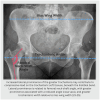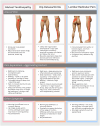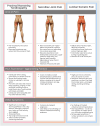Current and future advances in practice: tendinopathies of the hip
- PMID: 38601140
- PMCID: PMC11003818
- DOI: 10.1093/rap/rkae022
Current and future advances in practice: tendinopathies of the hip
Abstract
Tendinopathy describes persistent tendon pain and loss of function related to mechanical loading. Two common hip tendinopathies seen in practice are gluteal tendinopathy and proximal hamstring tendinopathy. Both conditions can be frustrating for patients and clinicians due to the delay in diagnosis, significant disability caused and lack of response to common treatments. Tendinopathy is a clinical diagnosis and can most often be made using findings from the patient interview and pain provocation tests, without the need for imaging. Specific education and progressive exercise offer a low-risk and effective option for gluteal tendinopathy and result in greater rates of treatment success than corticosteroid injection, both in the short term (8 weeks) and at 1 year. Proximal hamstring tendinopathy is a common, but less researched, and under-recognized cause of persistent ischial pain. As research on proximal hamstring tendinopathy is limited, this review summarizes the available evidence on diagnosis and treatment following similar principles to other well-researched tendinopathies.
Keywords: GTPS; buttock pain; buttocks; gluteal tendinopathy; greater trochanteric pain syndrome; hamstring tendons; lateral hip pain; proximal hamstring tendinopathy.
© The Author(s) 2024. Published by Oxford University Press on behalf of the British Society for Rheumatology.
Figures








References
-
- Zwerver J, Mc Auliffe S, Rio EK. et al. ICON 2019: International Scientific Tendinopathy Symposium Consensus: clinical terminology. Br J Sports Med 2019;54:442–3. - PubMed
-
- Albers S, Zwerver J, van den Akker-Scheek I.. Incidence and prevalence of lower extremity tendinopathy in the general population. Br J Sports Med 2014;48:A5.1–A5.
-
- Fearon AM, Cook JL, Scarvell JM. et al. Greater trochanteric pain syndrome negatively affects work, physical activity and quality of life: a case control study. J Arthroplasty 2013;29:383–6. - PubMed
Publication types
LinkOut - more resources
Full Text Sources
Research Materials
